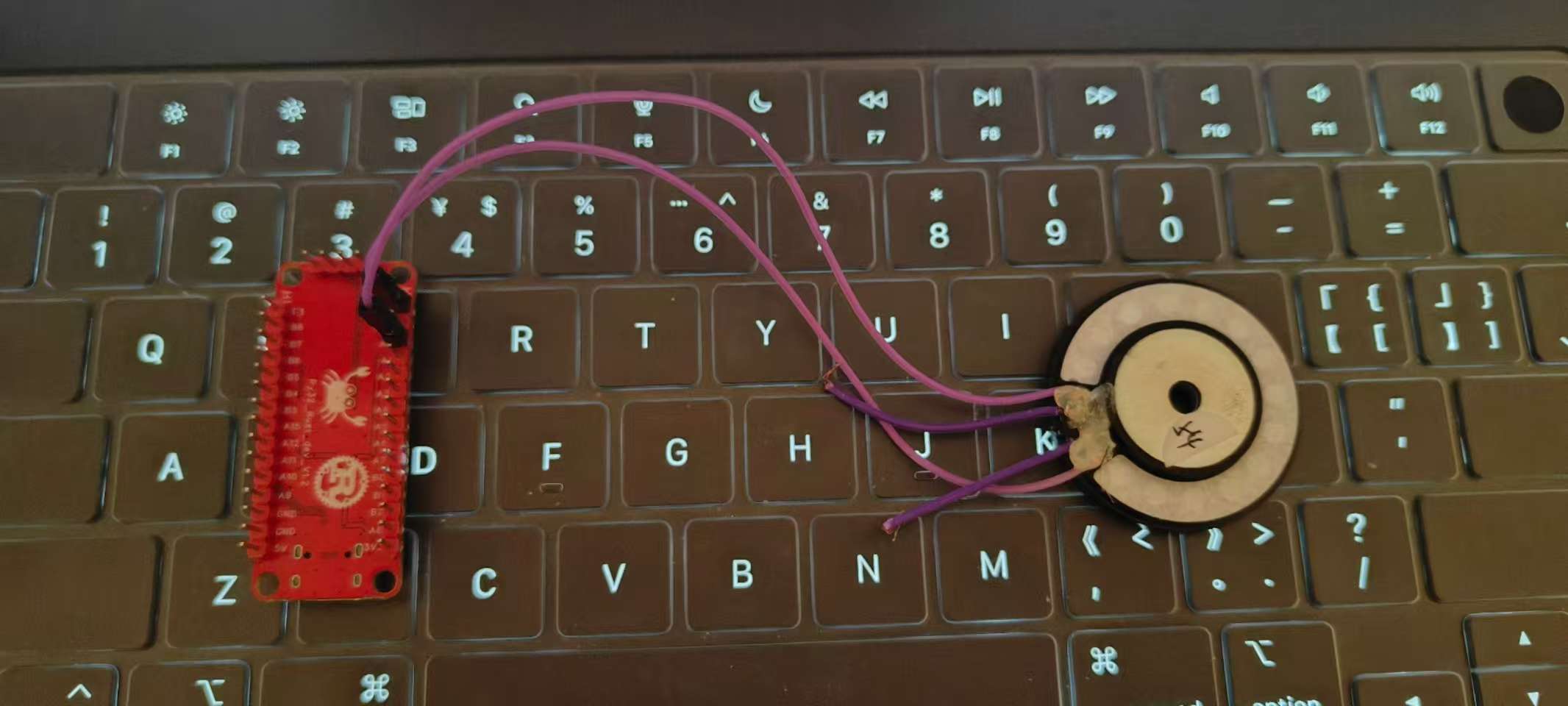引言:当单片机遇上音乐
你是否想过,用一颗只有64KB Flash的廉价单片机(如PY32F030)就能播放复杂的MIDI音乐?传统嵌入式音频开发往往需要高性能芯片,但通过Rust语言的高效和现代嵌入式生态,我们可以在资源受限的设备上实现比较满意的的音乐效果。
本文将带你探索:
- MIDI协议的解析工具
- 如何用Rust为ARM Cortex-M0单片机的定时器外设开发音频蜂鸣器程序
硬件准备:简约而不简单
核心器件:
- PY32_Rust_Dev Board:Py32f030主控,ARM Cortex-M0内核,主频48MHz,64KB Flash/8KB RAM
- 有源蜂鸣器(或无源蜂鸣器+驱动电路或其他喇叭)
硬件连接:
- 使用蜂鸣器的两端连接GND和PA0或PA3。
- 使用USB或SWD口供电

软件设计
- Midi转换工具
由于单片机资源有限,因此需要先将Midi文件解析为直接用于控制频率和延时,因此开发了一个小工具用于转换。部分代码如下:
#![allow(unused)] fn main() { for track in &tracks { match track { Track::Midi(midi) => { for m in midi { let event = &m.event; let tick_ms: u16 = (m.delta_time as f32 * one_tick_ms) as u16; println!("track event: {:?}", m); match event { MidiMsg::Meta { msg } => match *msg { Meta::SetTempo(tempo) => { let bpm_ms = tempo as f32 / 1000.0; one_tick_ms = bpm_ms / tpqn as f32; println!("tempo: {} bpm, one tick ms: {}", bpm_ms, one_tick_ms); } _ => {} }, MidiMsg::ChannelVoice { channel, msg } => match *msg { ChannelVoiceMsg::NoteOn { note, velocity } => { note_list.push(if velocity == 0 { Note::new(*channel as u8, 0, tick_ms) } else { Note::new(*channel as u8, note, tick_ms) }); } ChannelVoiceMsg::NoteOff { note: _, velocity: _, } => { // 关闭声音时,需要将note设置为0,否则会一直播放 note_list.push(Note::new(*channel as u8, 1, tick_ms)); } _ => { continue; } }, _ => {} } } } Track::AlienChunk(alien_chunk) => { for a in alien_chunk { println!("alien chunk: {}", a); } } } } }
可使用命令直接安装在Cargo中。
cargo install --git https://github.com/hysonglet/midi2rust.git
使用方式如下:
midi2rust ~/Downloads/PLACE.MID place
执行后将会生成rust数组如下:
#![allow(unused)] fn main() { struct Note { channel: u8, note: u8, delay: u16, } pub const MIDI_CONTENT: [Note; 5898] = [ Note { channel: 0, note: 60, delay: 24705, }, Note { channel: 0, note: 0, delay: 192, }, ... Note { channel: 9, note: 0, delay: 3, }, ]; }
- 单片机播放MIDI音乐
单片机只需要遍历音频数组,执行播放指定的频率和延时即可,代码如下:
#![no_std] #![no_main] use core::u16; use hal::gpio::{Af, PinIoType, Speed}; // use hal::timer::advanced_timer::TimerChannel1Pin; use hal::timer::advanced_timer::{AnyTimer, ChannelConfig, ChannelOutputConfig}; use py32f030_hal::gpio::gpioa::PA0; use py32f030_hal::gpio::PinAF; use py32f030_hal::{self as hal, mode::Blocking, timer::advanced_timer::Channel}; use embassy_executor::Spawner; use embassy_time::Timer; // use hal::mcu::peripherals::TIM1; use embedded_hal_027::Pwm; use defmt::info; use {defmt_rtt as _, panic_probe as _}; #[embassy_executor::main] async fn main(_spawner: Spawner) { info!("time1 start..."); let p = hal::init(Default::default()); let gpioa = p.GPIOA.split(); let timer: AnyTimer<_, Blocking> = AnyTimer::new(p.TIM1).unwrap(); let mut pwm = timer.as_pwm(); pwm.set_channel_1_pin::<_, _>(Some(gpioa.PA3), Some(gpioa.PA0)); // 配置定时器 pwm.config( /* 配置通道1 */ Some(ChannelConfig::default().ch(ChannelOutputConfig::default())), None, None, None, ); // 计数频率为1M pwm.set_frequency(1_000_000); pwm.set_duty(Channel::CH1, 50); // 设置计数周期为1000,则波形的频率为 1000_000/1000 = 1K // pwm.set_period(1000u16 - 1); // let max_duty = pwm.get_max_duty(); // // 33%的占空比 // pwm.set_duty(Channel::CH1, max_duty / 3); // 使能通道 pwm.enable(Channel::CH1); // 开始计数器 pwm.start(); loop { for note in &MIDI_CONTENT { let delay = note.delay; let channel = note.channel; let note = note.note as u32; // 只播放指定的 通道 if channel == 0 { let period = (1000_000.0 / NOTE_FREQ[note as usize] - 1.0) as u16; info!("freq: {}, note: {}, delay: {}", period, note, delay); Timer::after_millis((delay) as u64).await; pwm.set_period(period); } } } } const NOTE_FREQ: [f32; 128] = [ // 8.18, /* 0 */ 0.05, /* 0 */ 8.66, 9.18, 9.72, 10.3, 10.91, 11.56, 12.25, 12.98, 13.75, 14.57, /* 1~10 */ 15.43, 16.35, 17.32, 18.35, 19.45, 20.6, 21.83, 23.12, 24.5, 25.96, 27.5, /* 11~21 */ 29.14, 30.87, 32.7, 34.65, 36.71, 38.89, 41.2, 43.65, 46.25, 49.0, 51.91, /* 22~32 */ 55.0, 58.27, 61.74, 65.41, 69.3, 73.42, 77.78, 82.41, 87.31, 92.5, 48.99, /* 33~43 */ 51.91, 55.00, 58.27, 61.74, 65.41, 69.30, 73.42, 77.78, 82.41, 87.31, 92.5, /* 44~54 */ 98.0, 103.8, 110.0, 116.5, 123.5, 130.8, 138.6, 146.8, 155.6, 164.8, 174.6, /* 55~65 */ 185.0, 196.0, 207.7, 220.0, 233.1, 246.9, 261.6, 277.2, 293.7, 311.1, 329.6, /* 66~76 */ 349.2, 370.0, 392.0, 415.3, 440.0, 466.2, 493.9, 523.3, 554.4, /* 77~85 */ 1174.66, 1244.51, 1318.51, 1396.91, 1479.98, 1567.98, 1661.22, 1760.0, 1864.66, 1975.53, /* 86~95 */ 2093.0, 2217.46, 2349.32, 2489.02, 2637.02, 2793.83, 2959.96, 3135.96, 3322.44, 3520.0, /* 96~105 */ 3729.31, 3951.07, 4186.01, 4434.92, 4698.64, 4978.03, 5274.04, 5587.65, 5919.91, 6271.93, /* 106~115 */ 6644.88, 7040.0, 7458.62, 7902.13, 8372.02, 8869.84, 9397.27, 9956.06, 10548.08, 11175.3, /* 116~125 */ 11839.82, 12543.85, /* 126~127 */ ]; struct Note { channel: u8, note: u8, delay: u16, } const MIDI_CONTENT: [Note; 896] = [ Note { channel: 0, note: 71, delay: 26, }, Note { channel: 0, note: 0, delay: 465, }, ... Note { channel: 0, note: 0, delay: 0, }, ];
实验
如果下载了库py32f030-hal,执行以下命令即可用usb串口或stlink或jlink下载并运行:
# 使用jlink或stlink下载
cargo r --example embassy_pwm_midi
# 使用USB串口下载
# 生成bin文件
cargo objcopy --example embassy_pwm_midi -- -O binary embassy_pwm_midi.bin
# 串口下载
pyisp -s tty.usbserial-1140 -g -f embassy_pwm_midi.bin
固件大小为:
# Debug 编译
text data bss dec hex filename
22336 72 5752 28160 6e00 embassy_pwm_midi
# Release 编译
text data bss dec hex filename
19504 72 5752 25328 62f0 embassy_pwm_midi
快去写个低成本的生日祝福的歌曲吧
结语
使用这个小demo,音质和效果虽然有很多待改善的地方,但是仍然非常有趣,相比使用Arduno或C/C++去实现相同的功能,Rust的更加简洁,在这个小尝试中,我们可以感受到:
- Rust的零成本抽象在资源受限设备上的优势
- 现代嵌入式开发可以兼顾性能和开发效率
- 即使0.5美元的MCU也能实现复杂音频功能
附录
完整代码已开源([GitHub链接]),欢迎继续优化!
- midi2rust:https://github.com/hysonglet/midi2rust
- py32f030-hal: https://github.com/hysonglet/py32f030-hal
- midi音乐库:https://www.aigei.com/music/midi/
- midi频率表:https://newt.phys.unsw.edu.au/jw/notes.html